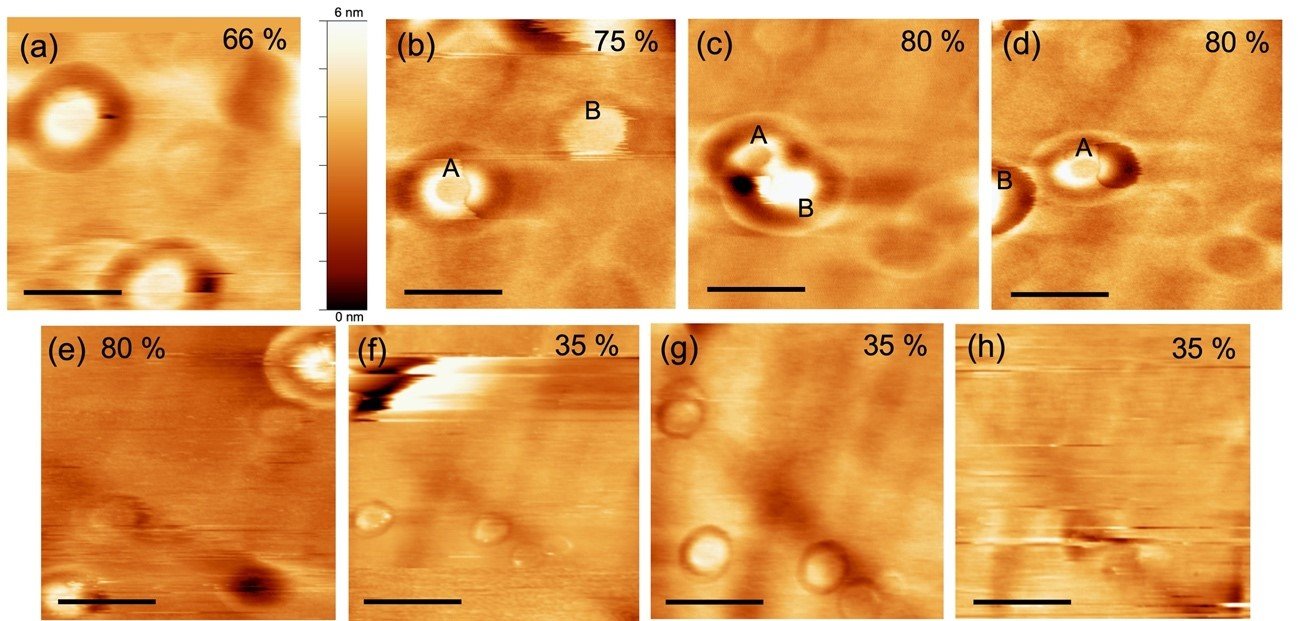
Dr. Yuki Araki, Prof. Toyoko Arai (Graduate School of Natural Science and Technology, Kanazawa University) and Dr. Taketoshi Minato (Institute for Molecular Science, National Institutes of Natural Sciences) have successfully visualized the behavior of nanometer-sized water droplets on glass surfaces. By observing the wetting process of silica glass in a humid air using frequency modulation atomic force microscopy (FM-AFM) (※1), they discovered that these nanoscale droplets, or “nano-water droplets”, form spontaneously with increasing humidity. Contrary to previous wetting models, these droplets do not grow larger but maintain their droplet state even in high humidity environment. Further measurements using peak force tapping atomic force microscopy (PFT-AFM) (※2) revealed that the nano-water droplets form not directly on the glass surface, but atop a gel-like layer on the glass. The visualization of these nano-water droplets provided insight into their unique movements across the glass surface, different from those of larger droplets, and suggested their potential role in mass transport on solid surfaces and involvement in various phenomena such as catalysis. The team plans to further explore the formation mechanisms of these droplets to determine if this phenomenon is universal across other materials as well. The findings were published in the online edition of “Scientific Reports” on May 10, 2024.
Background
The wetting of solid surfaces by water is a common phenomenon in everyday life, yet the intricate mechanisms behind it are not fully understood. Recent advancements in computational science and spectroscopy have facilitated detailed investigations into the adsorption of water molecules on glass surfaces in relation to humidity. Previous research suggested that water molecules uniformly adsorb and form a continuous film as humidity increases. However, more recent findings from nonlinear spectroscopy have indicated that water adsorption is non-uniform at around 50% humidity. We have employed Frequency Modulation Atomic Force Microscopy (FM-AFM), which enables the nanoscale observation of surface structures, to directly examine the microscopic dynamics of wetting on glass surfaces as they vary with humidity.
Summary of Research Findings
We began by increasing the relative humidity from 30% around the sample and observing the glass surface. At around 50% humidity, we detected water droplets approximately several hundred nanometers in size. Remarkably, these droplets maintained their size even as humidity exceeded 80%, remaining distinct in a high-humidity environment (nano-water droplets: Figure 1). Contrary to previous studies, which anticipated that these nano-water droplets would grow and eventually form a film with rising humidity, we found that it was actually the height of the droplets that increased, not their lateral size. Further, we measured the adhesive forces on the glass surface utilizing the peak force tapping atomic force microscopy (PFT-AFM). Our findings showed an increase in adhesion in areas without nano-water droplets as humidity rose, suggesting the formation of some type of liquid film. Upon comparing adhesion forces, it became apparent that the liquid film was more viscous than the droplets, hinting that the film might consist of a substance different from water. Currently, we believed that a silica gel-like layer, resulting from the reaction between the silica glass surface and the adsorbed water, has formed. Moving forward, we plan to further verify the presence of this silica gel-like layer. The visualization of nano-water droplets also clarified their diffusion across the glass surface, suggesting that these tiny droplets might play a role in the transport of substances on solid surfaces.
Future Directions
Understanding the behavior and properties of nano-water droplets can lead to more effective control of wetting, which is crucial for preventing material degradation. Moreover, the observed phenomenon of moving nano droplets in our study raises the possibility that they could also influence other processes, such as catalytic effects. Moving forward, by examining the behavior of nano-water droplets in greater detail and elucidating their mechanisms, we aim to gain a deeper understanding of the role of water at the microscopic level on solid material surfaces.
Acknowledgements
This work was supported by the Japan Society for the Promotion of Science (JSPS) Grants-in-Aid for Scientific Research (Basic Research (C), 23K04581) and the “Initiative for Realizing Diversity in the Research Environment”, MEXT. Additionally, part of this work was carried out at the Institute for Molecular Science, National Institutes of Natural Sciences, with support from the MEXT under the “Nanotechnology Platform” project (S-21-MS-0007) and the “Advanced Research Infrastructure for Materials and Nanotechnology” project (JPMXP1222MS0005).

Figure 1 Nano-water droplets formed on glass. They were observed above 50% RH, and disappeared when the humidity was reduced to around 30%. All scale bars represent 500 nm.
(c) 2024 Araki, et al., Scientific Reports, CC BY 4.0
(http://creativecommons.org/licenses/by/4.0/)
Information of the paper
Journal Name:Scientific Reports
Title:Microscopic behavior of nano-water droplets on a silica glass surface
Authors:Yuki Araki*, Taketoshi Minato, Toyoko Arai
Publication Date:2024. 5. 10
DOI:10.1038/s41598-024-61212-1
URL:https://www.nature.com/articles/s41598-024-61212-1
Glossary
※1:Frequency modulation atomic force microscopy (FM-AFM)
Atomic force microscopy (AFM) is a type of microscope that enables the observation of surface structures at atomic resolution. This method involves scanning the sample surface with a sharp probe and detecting variations in the cantilever’s vibrations caused by the forces between the probe and the sample using frequency modulation (FM) techniques. This approach not only allows for high-resolution observation of solid surfaces but also facilitates the study of the structure of water adsorbed on these surfaces, known as hydration structure.
※2:Peak force tapping atomic force microscopy (PFT-AFM)
PFT is a type of atomic force microscopy where the probe approaches and retracts from the sample surface while measuring the force exerted on the probe during approach and retraction. By detecting extremely small forces in the piconewton (pN) range, this technique allows for the creation of the maps of adhesion force and elastic modulus of the sample surface.
4713

